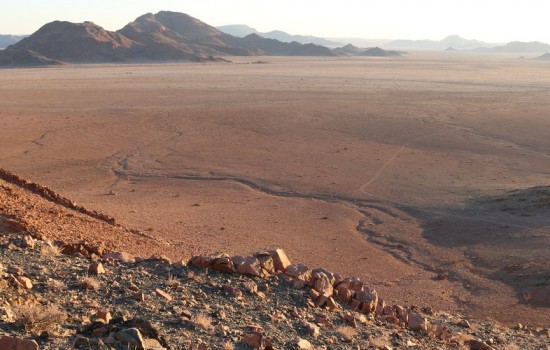Namib Naukluft Park
Als erkent agent voor NWR (Namibia Wildlife Resorts) beschikken wij over een wijde kennis. Daarom kunnen wij alle accommodaties
en sommige activiteiten vooraf boeken. Alle diensten en adviezen zijn gratis en zonder verder verplichtingen.

Namib-Naukluft National Park is an ecological preserve and part of the Namib Desert in southwestern Africa, thought to be Earth’s oldest desert. The park is the largest game park in Africa, and a surprising collection of creatures live in this very dry region, including snakes, geckos, unusual insects, hyenas, gemsboks, zebra, jackals and many more. Moisture comes in as a fog off the Atlantic Ocean and occasionally falls as soft rain, with the average 106 millimeters of rainfall per year concentrated in the months of February and April.
The prevailing winds that bring in the fog are also responsible for creating the park’s towering sand dunes, whose burnt orange color is a sign of their age and iron content. The orange color develops over time as iron in the sand is oxidized and like rusty metal, the older the sand, the brighter the color.
These dunes are by far the tallest in the world, in places rising to over 300 meters (almost 1000 feet) above the desert floor (higher than the Eifel Tower!). The dunes mostly taper off near the coast, and lagoons, wetlands, and mudflats located along the long shoreline attracting hundreds of thousands of birds.
‘Namib’ means open space and the Namib Desert gave its name to form the name Namibia meaning land of open spaces. The park was established in 1907 during the time of the German Colonial Administration that proclaimed the area between the Swakop River and the Kuiseb River a game reserve. The park’s present boundaries were established in 1978 by the merging of the Namib Desert Park, the Naukluft Mountain Zebra Park and parts of Diamond Area 1 including relatively small parts of surrounding government land.
The Namib Naukluft Park has some of the most unusual wildlife and nature reserves in the world covering an area of 49,768 km² (19,215 square miles). It is an area far larger than Switzerland, roughly the size of the US states New Hampshire and Vermont combined. The region is characterized by high, isolated inselbergs and koppies (the Afrikaans term for rocky outcrops), made up of dramatic blood red granites, rich in feldspars and sandstone. The easternmost part of the park covers a large part of the Naukluft Mountains.
Sossusvlei is a clay pan in the central Namib Desert, lying within the Namib-Naukluft National Park and in the Sesriem area. Fed by the Tsauchab River, it is known for the surrounding high, red sand dunes, which forms a major sea of sand. Very little vegetation surviving here, such as the camelthorn tree, is watered by infrequent floods of the Tsauchab River, which eventually slowly soaks into the underlying clay.
Dead Vlei is as Sossusvlei, surrounded by the highest sand dunes in the world, some reaching up to 300 meters, which rest on a sandstone terrace. The clay pan was formed after rainfall through a period of hundreds of years, when the Tsauchab river flooded, creating temporary shallow pools where the abundance of water allowed camel thorn trees to grow. When the climate changed and drought hit the area, the sand dunes encroached on the pan blocking the river from the area.
The trees died, as there no longer was any water to survive. There are some species of plants remaining, such as salsola and clumps of !nara, adapted to surviving off the morning mist and very rare rainfall. The remaining skeletons of the trees, which are believed to be about over 900 years old, are now black because the intense sun that has scorched them. Due to the dryness the wood does not decompose and form an eerie spectacle especially early morning or late in the day.


